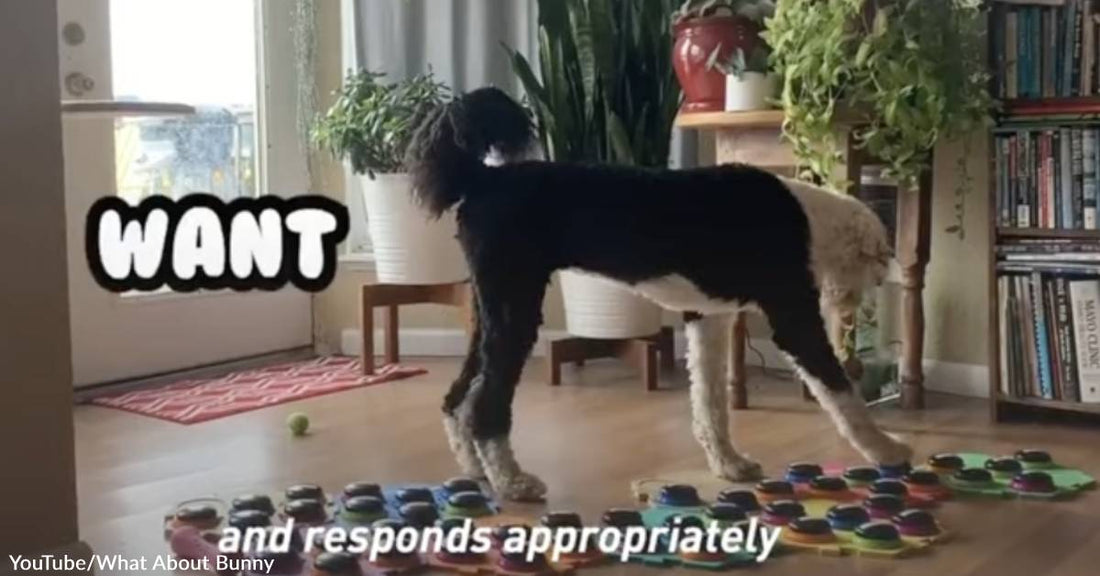How to Teach Your Dog to Talk Using Speech Buttons
Elizabeth Morey
Have you ever wished you could understand exactly what your dog wants all the time? Have you ever wondered how complex your pet's thought processes really are? If only you could take a peek inside their brain!
Well, you may be able to do just that (sort of) if you've got a lot of patience and a true desire to communicate with your pet and listen to what they're saying to you. Find out how here!
 Photo: YouTube/What About Bunny
Photo: YouTube/What About BunnyYou may have seen videos in recent years of dogs and cats pressing buttons arranged in hexagonal pads on the floor to indicate how they're feeling or what they want. It's become a popular trend among pet influencers and people who are just plain curious about whether a dog can communicate in plain English.
Perhaps you've thought your dog wouldn't be able to do that or that you wouldn't be able to figure out how to implement a system like that. Well, today you're in luck, because Alexis Devine and Bunny are going to be your teachers.
 Photo: YouTube/What About Bunny
Photo: YouTube/What About BunnyBunny has become famous on YouTube and other social media channels for her ability to communicate with her owner, Alexis, using dozens of buttons. Alexis has spent years training and teaching Bunny, starting with just one or two buttons at a time, and experimenting with the organization of the word patterns and types of words she gives Bunny to use.
Bunny, for her part, has been experimenting with combining groups of words to make new concepts that she doesn't even have buttons for! Because Bunny's vocabulary is limited to the words she's learned and has buttons for, she cannot always say what she wants to and has to get very creative at times. This means that Alexis must listen carefully when Bunny "speaks" and try to decode her messages.
 Photo: YouTube/What About Bunny
Photo: YouTube/What About BunnyBut with a little patience and practice, the pair has gotten to know each other well and can usually do a good job of communicating together. Now that they've got some experience under their belts, they're ready to show you the best methods for starting your pet on the road to communicating with buttons.
If you want to train your dog to communicate better with you, you've got to be willing to put in some work. Most dogs are willing and eager to communicate with their owners, so chances are you can make it work no matter the breed of dog you own. Here's what you need to get started:
 Photo: YouTube/What About Bunny
Photo: YouTube/What About BunnyAlexis recommends teaching your dog a few basic commands before you begin so that they understand a little bit about human communication. It's important that you try to understand their body language as well. Then start with these three very basic words most dogs can pick up quickly: outside, play, and all done.
Add one or two words at a time each time your pet seems to have mastered their lessons, and always choose words that make sense for your dog and are likely to be used a lot. Before you know it, your pup will be communicating on a multitude of complex topics!
 Photo: YouTube/What About Bunny
Photo: YouTube/What About BunnyAs you continue to add words to your dog's vocabulary, take care to organize them in ways that make sense for how they're used so that your dog can easily find them.
Check out the video below to learn how to begin implementing a communication system like this one in your home!
https://www.youtube.com/watch?v=iXy7NTGHAyQ
We suspect that teaching a cat to communicate in English is a bit tougher, but there are plenty of kitties who have mastered this skill! If you've taught your pet - no matter what type - to talk, we'd love to hear your story!

Elizabeth Morey graduated summa cum laude from Aquinas College in Grand Rapids, MI, where she dual majored in English Literature and Spanish with minors in Writing and Business Administration. She was a member of the school's Insignis Honors Society and the president of the literary honors society Lambda Iota Tau.
Some of Elizabeth's special interests include Spanish and English linguistics, modern grammar and spelling, and journalism. She has been writing professionally for more than five years and specializes in health topics such as breast cancer, autism, diabetes, and Alzheimer's disease. Apart from her work at GreaterGood, she has also written art and culture articles for the Grand Rapids Magazine.
Elizabeth has lived in the beautiful Great Lakes State for most of her life but also loves to travel. She currently resides a short drive away from the dazzling shores of Lake Michigan with her beloved husband.




















